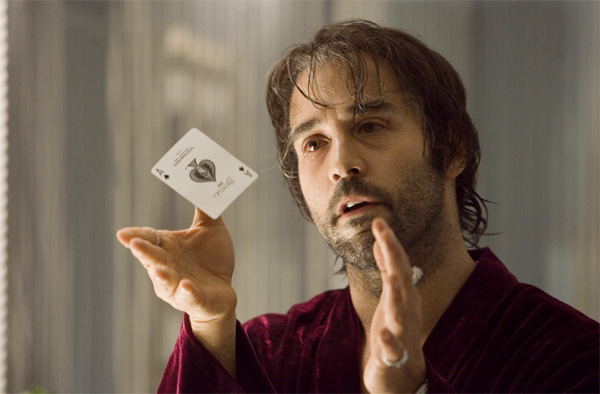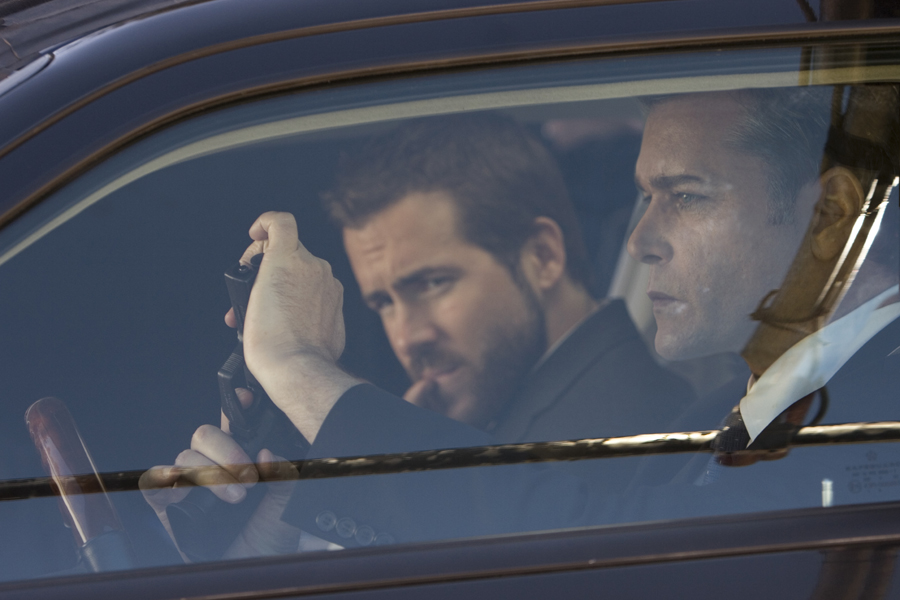
That teaser trailer, and the advertising and marketing for the film at the time, provide a perfect example of just where Smokin’ Aces went so wildly off the tracks. With good reason distributors Universal were hard selling their new movie from one of Hollywood’s hottest young prospects as the carnage junkie event of the year. This would be a K of film heroin for a massive and happily paying clique of addicts, a film marrying together a simple concept with stylish execution. It would be one hell of a high. Why the film was so badly miss-sold can be explained one of two ways: A. The good people at Universal’s marketing department had not actually watched the full film, or read all of the script, and had based their sales on only an element of the film; B. The intent was to sell the film as a mindless and visceral flick as a set up for its meta twist. Either way, the strategy was misguided because Smokin’ Aces isn’t any of those things in anything other than vague, transparent disguise. Either way, its audience was going to be pissed at the deception. And, sadly, even if the hype had been orchestrated in a more balanced and discipline manner, it still would have been attempting to draw attention to something that would only just about avoid bombing dramatically. That’s because we’re really discussing two very different films in one, an attempt at over-thought hybridization which fails to form a cohesive gel. Trying to get to the bottom of Aces simply uncovers what Carnahan was trying to do, not evidence of success.
The trouble presented here is spoils. Ironically, upon the film’s release there was much critical talk of Tarantino imitation; the truth is that the only thing Smokin’ Aces has in common with Tarantino is his second era habit of over-indulgence. In the same way that Kill Bill and Death Proof are horribly indicative of a director without restraints losing his discipline or focus on decent storytelling, here Carnahan followed up the hard boiled and tight Narc with a script that appears to be engulfed by civil war, such is the crude variety of themes, tones, plots and purposes. The aforementioned unconditional action is delivered in the form of a simplistic and effective pitch; a mob informant is locked up in a hotel protected by the FBI and his own personal bodyguards, and becomes the target for various bizarre and variably effective hitmen from across the world all attempting to cash in on a $1m reward.
Sometimes, though, it is the least complicated set ups that create the most narrative problems for a writer perhaps a little too eager to follow up on the cult success of his financially pinched big break. Another example of this would be Martin McDonough’s Seven Psychopaths, a film that ends up being good while shooting for something greater, perhaps a little too clever for its own good. With Smokin’ Aces, Carnahan attempts to combine the action with a running theme of hoodwinking subversion and exploration of genre tropes. This might have worked, given that Carnahan is an excellent screenwriter as proven by The Grey. But the problem, the straw that breaks the film’s back, is that rather than making a thoughtful subverted action movie, he actually makes both an action film and a thoughtful subversion independently. Too much imagination is put into the climactic gun battles and murders, too many ideas packed into proceedings, for the actual point to carry any meaning.
A perfect example of this lies within a contrasting pair of subplots, firstly the FBI operation to protect Mr. McGuffin Buddy ‘Aces’ Israel. While the higher ranks of the Bureau, represented by Andy Garcia (and a bizarre accent), attempt to broker a deal with the eponymous snitch, field agents Ryan Reynolds and Ray Liotta go about actually keeping him alive. Includes legal proceedings, journeys into the past exploring the fate of a dedicated former undercover agent, and more plot twists than actual content. This portion of the film is actually very similar to Narc in terms of style and thematic purpose. It’s built on far more drama and emotion than you would expect, and ultimately delivers the film’s conclusion.
Secondly, the strange journey undertaken by ex-cop bail bondsman Hollis Elmore (Martin Henderson), which seems to be a mostly comical distraction which ultimately doesn’t lend much to the main plot other than ending on the vengeful killing of one of the other assassins. This story strand takes in Ben Affleck’s surprisingly early death, Jason Bateman’s over the top role as a perverted and depressed lawyer, and an incredibly awkward sequence in which Elmore houses up with a nurse and her karate wigger grandson. While there are various other stories going on, these two provide evidence that while Carnahan clearly had too many chefs working on the broth, he also had something more cerebral in mind when presenting his story. While the two plotlines belong to completely different films, there is a sense that this is deliberate.
The comedy of the Elmore story is pure action movie fodder; occasionally tasteless humor used as a sharp detour from the violence, lightening the mood while cranking up the stakes. Contrast this to the seriousness and mystery of the FBI plot, which is pure noir thriller. This mixture makes for a foul tasting cocktail but makes an effort to do something different, while also laying down justification for the fact that the cartoon silliness of the fighting can be followed by the PTSD of the scenes following it. Taraji P. Henson uses a .50 caliber Barrett sniper rifle to lay waste to a hotel floor’s worth of government suits in a scene complete with rag doll CGI effects, war-like destruction and the kind of cinematic excess symptomatic of mid-90’s fodder, and upon running out of bullets we see shell shocked characters wandering aimless and traumatized through the rubble, as Clint Mansell’s score informs up this is meant to be pathos. Except only a few minutes earlier Kevin Durand fell on his own chainsaw while a pre-Kirk Chris Pine escaped a failed and machete led charge on hotel security by posing as an overwhelmed guard in a scene played out for laughs. The theme here, it seems, is that the pumped up assassins crack off jokes and banter in the build up to their assault, launch the attack in visceral and artery bursting action, and are greeted at the other end by desolation and tears and the senseless death and damage done.
This idea would hold a lot more weight if it weren’t blatantly contradicted by various other elements of the film that are already clashing and chafing at such close proximity. It seems like the each subplot is presented for different purposes; the FBI plot for mature and intelligent pondering, the Elmore tale for cheap laughs, the neo-Nazi Tremor Brothers for insane black humor, Henson and Alicia Keys’ hitwomen duo for sassy jive reminiscent of blaxploitation, Piven’s Israel and his losing battle for freedom as emotional character study and the missions of mysterious assassins Nestor Carbonell and Tommy Flanagan for comic book ingenuity. So many genres and styles in one go make for an interesting set of clashing short stories which in a chronologically non-linear project may have delivered a cult classic show reel of a flick. As one mass though, it becomes a mess as Carnahan holds on to the idea of subverting the dynamics of the action thriller while simultaneously working too hard to shove in all of his ideas for his own straight shooting blockbuster. The film’s ending perhaps proves beyond a shadow of a doubt that Carnahan’s intentions were for something for more serious that the Ace of Spades teaser would suggest.
Overwhelmed by the loss of his partner and so many government men, Agent Ryan Reynolds gets to the bottom of the FBI plot and learns from Andy Garcia that one huge misunderstanding has powered most of the film’s narrative. A mob boss’ order to bring him Israel’s heart was literal, as said mob boss is dying, said mob boss is actually Israel’s biological father, and said mob boss was in fact the undercover agent previously mentioned. So Ray Liotta and the other faceless suits died so that the bad guy could have a heart transplant to keep him alive so he could be debriefed by the Bureau. Agent Reynolds doesn’t like it and a pique of vengeful despair pulls the plug on both men, rendering the film’s events meaningless. The acting, direction, writing and score all inform us that this is a tearful and bare knuckle conclusion to the film, one that should resonate emotionally. Or at least, that this is what it presents itself to be. The reason you’re frowning rather than choking on a lump in your throat is that this is an epitaph to the reality behind the carnage of such action films. It’s probably the perfect ending to the FBI storyline…but that’s just one film within this film that gets lost in the crowd.
Whether it was over-ambition or over-enthusiasm which ultimately overcooked Smokin’ Aces into charcoal isn’t entirely clear, but the feeling as the star studded closing credits begin to roll leans more towards the former. There are simply too many hints and clues pointing towards something unfulfilled within a busy and clustered narrative to simply dismiss it as being an overly indulgent waste of talent, potential and time. In attempting to write something different, something perhaps examining the dynamics of schlock disposable action, Carnahan unintentionally creates twins within the same body and two films are left to fight it out for supremacy in the space of one. The result is that neither wins, and everybody (including us) loses. Oh, but for the sadness at seeing some good in the bad. It just reminds you that the Ace of Spades trailer is probably a better movie all on its own.
This has been a Strange Interpretation…
Scott Patterson





